R.J. Stowell's Blog: rjsomeone, page 25
May 19, 2020
Will Love Tear Us Apart?
Ian Curtis wrote "Love Will Tear Us Apart," his melancholy post-punk classic on the inevitable dissolution of a failing relationship, in August 1979. It's a clear contrast to the boisterous aggression that marked early punk, with languid, hopeless vocals and bleak lyrics. The song became his epitaph, and Joy Division's. By May 1980, Curtis had taken his own life, "Love Will Tear Us Apart" chiseled on his headstone. Joy Division floundered for a while and reformed as seminal post-punk band New Order. In the more than three decades since Curtis wrote the tune into the rock 'n' roll pantheon, it's been covered a thousand times. But Gordon Calleja and Mighty Box have shifted mediums entirely and turned “Love Will Tear Us Apart” into a game.
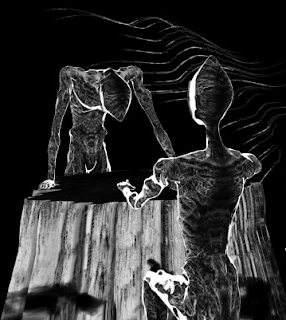 Will Love Tear Us Apart is a videogame adaptation of Joy Division's dirge-pop standard and there's nothing else quite like it. The art is grim and hand-drawn, the color palette starkly monochromatic, the gameplay strangely (and intentionally) unsatisfying. A playthrough clocks in at about the length of an EP, and in that time WLTUA recreates the emotions of a doomed relationship with the game mechanics of three dramatically different genres (one based on each verse of the song): a rock-paper-scissors puzzle, a fiendishly difficult Pac-man-esque maze chase, and a first-person exploration of an emotional landscape. Developed by the Malta-based Mighty Box from a design concept by games academic Gordon Calleja, WLTUA doesn't try to inspire feelings of triumph and accomplishment in its players. Instead, Calleja & co. strived to mimic the emotions of frustration and loss on the melancholy path to a breakup. In the first puzzle, the player sits across from his/her significant other and each chooses to understand, cajole, or angrily dominate the partner.
Will Love Tear Us Apart is a videogame adaptation of Joy Division's dirge-pop standard and there's nothing else quite like it. The art is grim and hand-drawn, the color palette starkly monochromatic, the gameplay strangely (and intentionally) unsatisfying. A playthrough clocks in at about the length of an EP, and in that time WLTUA recreates the emotions of a doomed relationship with the game mechanics of three dramatically different genres (one based on each verse of the song): a rock-paper-scissors puzzle, a fiendishly difficult Pac-man-esque maze chase, and a first-person exploration of an emotional landscape. Developed by the Malta-based Mighty Box from a design concept by games academic Gordon Calleja, WLTUA doesn't try to inspire feelings of triumph and accomplishment in its players. Instead, Calleja & co. strived to mimic the emotions of frustration and loss on the melancholy path to a breakup. In the first puzzle, the player sits across from his/her significant other and each chooses to understand, cajole, or angrily dominate the partner.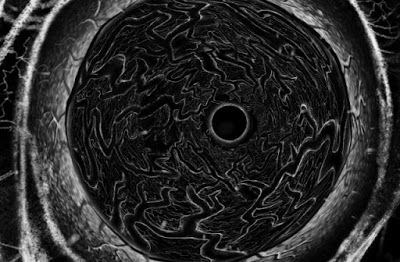 While each verse is represented by a different game genre, the strong and distinctly creepy art style ties the work together as a whole, and each level is tied together by impressive animation sequences. The game starts by transforming a series of wave-forms (a clear reference to Joy Division’s iconic Unknown Pleasures album artwork) into a landscape where the first verse-game takes place. The second level challenges the player to control both members of the doomed relationship simultaneously through two different mazes, a reinterpretation of Curtis' "And we’re changing our ways / taking different roads." The final stage puts the player in a desolate first-person black and white landscape and guides them to the conclusion of the relationship entirely by sound.
While each verse is represented by a different game genre, the strong and distinctly creepy art style ties the work together as a whole, and each level is tied together by impressive animation sequences. The game starts by transforming a series of wave-forms (a clear reference to Joy Division’s iconic Unknown Pleasures album artwork) into a landscape where the first verse-game takes place. The second level challenges the player to control both members of the doomed relationship simultaneously through two different mazes, a reinterpretation of Curtis' "And we’re changing our ways / taking different roads." The final stage puts the player in a desolate first-person black and white landscape and guides them to the conclusion of the relationship entirely by sound.The grotesque hand-drawn graphics and sound-alike score go a long way in transmitting the texture of "Love Will Tear Us Apart," but the game's most intriguing achievement is the imperfect translation of Curtis' hopeless lyrics into game mechanics. While "Love Will Tear Us Apart" is an inevitable statement to be received passively and without hope, Will Love Tear Us Apart? asks the player to answer the question, and struggle through the dying embers of a romantic flame.
https://willlovetearusapart.com/game.html
Published on May 19, 2020 17:03
Just Walk Away

In the early hours of May 18th 1980, two months before his 24th birthday, Ian Curtis committed suicide at his home in Macclesfield, Cheshire, England and for many of us, life changed dramatically. Shortly before the end of Ian's life, his wife Deborah started divorce proceedings; Ian was no longer living at the family home. In April 1980 he was admitted to the hospital for an overdose of epilepsy medication. It's not clear whether this was a suicide attempt or a plea for help. What is clear is that by the last month of his life, Ian found the pressures on him greater than ever, not least of which was the band's first American tour. On Saturday, May 17th, Ian canceled arrangements to meet friends and returned to his home on Barton Street. Deborah was working the bar at a local disco and had left their daughter, Natalie, at his parents. Ian watched Stroszek, a film by Werner Herzog, and when Deborah's shift ended, she appeared at the door, they spoke for a while, then, at his behest, she left.
 Alone again he listened to Iggy Pop and wrote a letter to his estranged wife. Then, in the early hours Sunday morning, he hung himself in the kitchen. His body was found by Deborah when she returned later that day. Some were left with the impression that he was dreading the American tour and the traveling involved. Others say he was looking forward to the tour with cautious excitement. A third view, advanced by Deborah Curtis, was that the prospect of touring did not worry him at all: he knew that he would not be going. Although no one can agree on whether Ian's suicide was long-planned or an impulsive decision, none will argue that his illness and drug regimen affected his judgment.
Alone again he listened to Iggy Pop and wrote a letter to his estranged wife. Then, in the early hours Sunday morning, he hung himself in the kitchen. His body was found by Deborah when she returned later that day. Some were left with the impression that he was dreading the American tour and the traveling involved. Others say he was looking forward to the tour with cautious excitement. A third view, advanced by Deborah Curtis, was that the prospect of touring did not worry him at all: he knew that he would not be going. Although no one can agree on whether Ian's suicide was long-planned or an impulsive decision, none will argue that his illness and drug regimen affected his judgment.
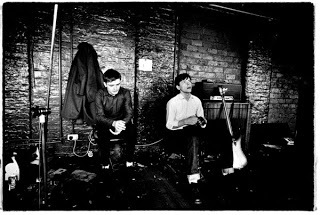 Joy Division was one of four essential post-punk bands that trace their origins to a now-legendary 1976 performance by the Sex Pistols at the Lesser Free Trade Hall in Manchester. Along with founding members of the Buzzcocks, the Smiths and the Fall, Mancunians Bernard Sumner and Peter Hook decided in the immediate aftermath of the Pistol's show to form a band. And while the DIY ethos of the Sex Pistols gave them the wherewithal to call themselves a band when they could barely play their instruments, the band they became was the first punk-inspired group to leave the punk-rock ideology behind. The critical step in that direction was the selection of Ian Curtis from among the respondents to the "Singer Wanted" listing they posted in a local record store. Curtis was less an aspiring rock star than an aspiring poet, and his moody, expressive lyrics veered the group's sound away from thrash and anger and toward something far more spare, speculative and melancholy.
Joy Division was one of four essential post-punk bands that trace their origins to a now-legendary 1976 performance by the Sex Pistols at the Lesser Free Trade Hall in Manchester. Along with founding members of the Buzzcocks, the Smiths and the Fall, Mancunians Bernard Sumner and Peter Hook decided in the immediate aftermath of the Pistol's show to form a band. And while the DIY ethos of the Sex Pistols gave them the wherewithal to call themselves a band when they could barely play their instruments, the band they became was the first punk-inspired group to leave the punk-rock ideology behind. The critical step in that direction was the selection of Ian Curtis from among the respondents to the "Singer Wanted" listing they posted in a local record store. Curtis was less an aspiring rock star than an aspiring poet, and his moody, expressive lyrics veered the group's sound away from thrash and anger and toward something far more spare, speculative and melancholy. The soundscape that Joy Division developed over the course of 1977-79 included the addition of the synthesizer—an absolute violation of the lo-fi punk aesthetic, but a choice that marked the beginning of what would eventually, be called the New Wave. Unknown Pleasures and "Love Will Tear Us Apart" made Joy Division cult heroes in the UK, and Ian Curtis's mesmerizing stage demeanor turned him into a post-punk icon.
The soundscape that Joy Division developed over the course of 1977-79 included the addition of the synthesizer—an absolute violation of the lo-fi punk aesthetic, but a choice that marked the beginning of what would eventually, be called the New Wave. Unknown Pleasures and "Love Will Tear Us Apart" made Joy Division cult heroes in the UK, and Ian Curtis's mesmerizing stage demeanor turned him into a post-punk icon.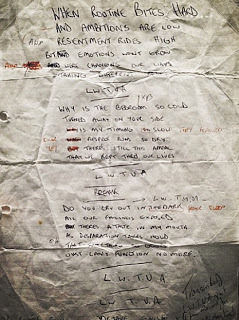 Ian Curtis Handwritten LyricsThough he concealed his condition from his bandmates until he suffered a major seizure in their tour van following a gig in December 1978, Curtis was epileptic. Some have speculated that depression over his worsening medical condition or the side effects of his medication led to Curtis's suicide. Whatever his reasons, Ian Curtis took his own life just two days prior to Joy Division's planned departure on a potentially career-changing tour of America. Two months after Curtis committed suicide, the surviving members of Joy Division fulfilled a promise they'd made to one another by retiring their group's name and continuing on through the 80s with the name New Order.
Ian Curtis Handwritten LyricsThough he concealed his condition from his bandmates until he suffered a major seizure in their tour van following a gig in December 1978, Curtis was epileptic. Some have speculated that depression over his worsening medical condition or the side effects of his medication led to Curtis's suicide. Whatever his reasons, Ian Curtis took his own life just two days prior to Joy Division's planned departure on a potentially career-changing tour of America. Two months after Curtis committed suicide, the surviving members of Joy Division fulfilled a promise they'd made to one another by retiring their group's name and continuing on through the 80s with the name New Order.Bassist, Peter Hook recalls: "After something like that, you don't know what to do. The only thing constant in our lives was practice. When we left Ian's funeral we said: 'See you at practice.' That Sunday afternoon I got the six-string riff to 'Dreams Never End,' which we recorded as New Order. We just put Joy Division in a box and closed the lid, but it enabled the remaining three of us to establish ourselves as New Order. Through New Order people continued to become aware of Joy Division.
 "I know Joy Division will always be overshadowed by Ian's death. I remember driving to the tax office to tax my old £100 Jag when the chart rundown went: In at No 11, Joy Division with 'Love Will Tear Us Apart.' I turned it off. For us, Joy Division had gone.
"I know Joy Division will always be overshadowed by Ian's death. I remember driving to the tax office to tax my old £100 Jag when the chart rundown went: In at No 11, Joy Division with 'Love Will Tear Us Apart.' I turned it off. For us, Joy Division had gone."I think, as with Kurt Cobain much later, it was the death of innocence. Ian's daughter didn't have a father. Did independent music gain an icon? I'm too close to it. I had to view the death of Joy Division as a new start. All the battles we went through in Joy Division, we had to go through once again.
"Listening to Closer again, it's heart-rending. Ian created a wonderful testimony of how he felt at the time: apprehensive, fearful, but powerful. Not in control of your destiny: you can hear how that break evolved."

Published on May 19, 2020 12:42
A Stacked Plot of Radio Signals From a Pulsar - 40 Years

I’ve played nothing but Unknown Pleasures for the past two days. Here’s my tribute to Curtis without once saying RIP.
1. The Cambridge Encyclopaedia of Astronomy, edited by Simon Mitton. Prentice-Hall of Canada, by Terwin Copplestone Publishing, 1977. No source credit for the plot can be found in the text, other than a general book-wide "diagrams and graphs by Michael Robinson" nod. There's a four-page summary about pulsars and several diagrams but not much detail about the stacked plot itself, beyond the figure caption: "Successive pulses from the first pulsar discovered, CP 1919, are here superimposed vertically. The pulses occur every 1.337 seconds. They are caused by a rapidly spinning neutron star."
2. Graphis Diagrams: The Graphic Visualization of Abstract Data, edited by Walter Herdeg, The Graphis Press, Zurich, 1974. Included in a catalogue of data visualizations on scientific topics, attributed on the credits page to the Arecibo Radio Observatory: "Von einem Computer erzeugte illustration von achtzig aufeinanderfolgenden Pulsperioden des ersten Pulsars, der beobachtet wurde. Die Durchschnittsbreite der Pulse ist weniger als eine 50tausendstel-Sekunde. Das Diagramm wurde vom Arecibo Radio-Observatorium in Puerto Rico hergestellt. Aus Scientific American, 'The Nature of Pulsars,' von J. P. Ostriker (U.S.A.)." A translation includes the definition of a Pulsar: Pulsars are types of neutron stars; the dead relics of massive stars. What sets pulsars apart from regular neutron stars is that they're highly magnetized, and rotating at enormous speeds. Astronomers detect them by the radio pulses they emit at regular intervals.
3. “The Nature of Pulsars” by Jeremiah P. Ostriker, Scientific American, January 1971 (pages 48-60); Credited to Arecibo Radio Observatory in the issue's illustration credit box on page 4.
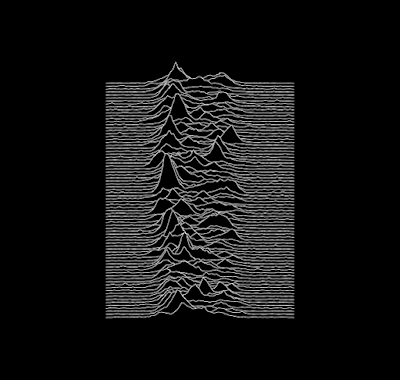 4. Joy Division, Unknown Pleasures, 1971 (AM10). In the infinite debate of influence or confluence, Joy Division's place is as secure as its equally esteemed mythos, yet the lens of mythology ofttimes blurs the cruel and unforgiving nature of reality, ignoring the context that was responsible for the music we were enjoying in the first place. Though viewed as the catalyst for what would become New Order, the death of Ian Curtis is no less tragic even when cast in the positive light of his unparalleled influence. And while New Order's acclaim and success is deserved and historic in its own right, the band's clear distinction both in sound and in scope separate it from the overwhelming, albeit brief, presence of Joy Division.
4. Joy Division, Unknown Pleasures, 1971 (AM10). In the infinite debate of influence or confluence, Joy Division's place is as secure as its equally esteemed mythos, yet the lens of mythology ofttimes blurs the cruel and unforgiving nature of reality, ignoring the context that was responsible for the music we were enjoying in the first place. Though viewed as the catalyst for what would become New Order, the death of Ian Curtis is no less tragic even when cast in the positive light of his unparalleled influence. And while New Order's acclaim and success is deserved and historic in its own right, the band's clear distinction both in sound and in scope separate it from the overwhelming, albeit brief, presence of Joy Division.Perhaps the most profound and uncanny part of Joy Division's story is found in the band's vapor-like existence, spanning only two full-length albums and an EP. It's the kind of story the world of rock 'n' roll readily mutates into lore, with the spectacle unfairly overshadowing the validity of the music itself. The song that arguably started it all (notwithstanding, of course, the single-only icon "Love Will Tear Us Apart," AM10), is unmistakably "Disorder." The first track from Joy Division’s debut LP immediately kicks in the obliquely subdued soundscape the band would pioneer. Beginning with Stephen Morris' hiccuped drums and Bernard Sumner's minimal guitar work, the song's pace is exacting, gradually unraveling both lyrically and musically, with Ian Curtis' icy baritone punctuating the song's staccato rhythm (and possibly mimicking his epilepsy). The song's gradual descent into sonic disarray is something that might have detracted from any other band whose vocalist wasn't Ian Curtis. He reverberates the word "feeling" in a fevered, isolated haze to close the song and to essentially begin and even end Joy Division’s tragic and influential story. "I’ve been waiting for a guide to come and take me by the hand" remains a startling opening line for any album. When Curtis wrote it he was emerging from an adolescent worship of decadent rock poets such as Iggy Pop, Lou Reed and David Bowie, yet the line contains none of their bravado. Hindsight has robbed Curtis of much of his poetic genius. Today his lyrics are analyzed in reference to his suicide, they should really be read in deference to a young man in love with rock 'n' roll and suffering from a debilitating illness. Or maybe just from a young man.
Clear, stark and darker than night, "She's Lost Control" is one of the group's finest recordings. Disembodied, Ian Curtis' voice sits uncomfortably in the middle, intoning the lyrics that would come to define his battle with epilepsy. "New Dawn Fades," is perhaps the summation of the atmosphere of dread that exists on Unknown Pleasures. Defying description, the album seems to scream against an unknown terror. Half in love with darkness, Joy Division seem terrified of being consumed by it. Driven by a thick bassline from Peter Hook, the mathematical beats of Stephen Morris and the restrained guitar playing of Bernard Sumner, the track takes the dark tones of The Velvet Underground and melts them into thick black tar. When Curtis intones "a loaded gun won’t set you free" he may have had one eye on his own fate, but he was also looking at a country fast falling apart. Terrorist attacks at home and abroad, a government brought to its knee by militants, and Curtis in the middle "hoping for something more." It was the Clash with sorrow rather than anger.
Published on May 19, 2020 09:52
May 18, 2020
L.A. Album Cover Locales
Many an album cover was photographed in L.A., it goes without saying. Where, though? Here's a tour.
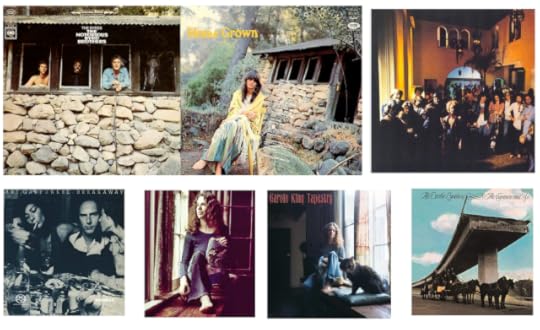
You can't go inside, sorry, but Carole King and her Kitty were photographed in Carole's home at 8815 Appian Way, high above Sunset Plaza. Carole had great success in the 60s writing for others, from the Monkees to the Byrds, but it was Tapestry, among the bestselling albums of all time, that was her coming out party. An excerpt from the photographer's obituary says it better than I can: "Photographer Jim McCrary was on the verge of shooting one of his most famous images when he stopped to ask singer Carole King if the cat sleeping across the room could be part of the tableau.
"When King assured him that her pet was docile, he carried the tabby and its pillow to the window ledge and into the frame. By the third click of his camera, the cat had slipped away but McCrary had what he needed: a picture of both the barefoot songstress and her whiskered feline that became the cover of King's landmark 1971 Tapestry album."
An abandoned house in Topanga Canyon was used for the front cover of The Notorious Byrd Brothers (1968) and the back of Linda Ronstadt's Hand Sown Home Grown (1969). The Byrds were photographed by rock/celeb photographer Guy Webster at what he referred to as an old stable in Malibu Canyon, but the house has recently been spotted and verified one canyon over in Topanga, not far from the old Topanga Corral (647 Old Topanga Road).
The Byrds as pictured on the cover are: (left to right) Chris Hillman, Roger McGuinn, and Michael Clarke. Although David Crosby appeared on several tracks on the album, he had unofficially been fired from the band. There is speculation that the inclusion of the horse (rather than Crosby) was an inside joke, but Guy Webster denies the accusation. Linda Ronstadt appears on the right as photographed by Eddie J. Caraeff.
The covers for two Love LPs, Love and Da Capo, were shot at what was once Bela Lugosi's $30,000 mansion at 2227 Outpost Drive. Today a private residence, the home was purchased in 2018 for nearly $4 million.
Many of the photo locations are obvious: Bonnie Raitt's cover for Takin' My Time is a waiting room in the glorious Union Station downtown and, while there isn't a “Hotel California,” the LP's iconic location is the Beverly Hills Hotel. The interior shot of the band, though, is not. That instead is the Lido Apartments at 6500 Yucca Street, just a stroll from Hollywood Blvd. Head down Highland passed the Hollywood Bowl and turn right on Barham Blvd. Once over the ridge, you’ll see Warner Bros. Studios, the location for Pink Floyd's Wish You Were Here. It was also the site for Petula Clark's These Are My Songs, which had the hit "Don’t Sleep in the Subway." The Doobie Brothers used a collapsed freeway overpass from the 1971 Sylmar quake to photograph their The Captain and Me LP. Last one for the obvious: Going For the One from Yes features the twin triangular buildings, the Century City Towers.
For me, a sentimental one is the Norman Seeff photo for Art Garfunkel's Breakaway, which was taken at a booth where I’ve sat on numerous occasions in Dan Tana’s (9071 Santa Monica Blvd.), that splendid survivor of an ever-expanding Lost L.A. (We will miss you, Mike).
#milesfromnowhere
Published on May 18, 2020 09:13
Calif. - Buy This Book!
Get your copy of Calif. by R.J. Stowell at Amazon or read it on your Kindle. And remember, Kindle Unlimited is free the first month. Thousands of titles from Harry Potter to Lord of the Rings - and Calif., of course! Here's the link.
Watch with sound, share and enjoy!
Signed copy? Contact me at rjsomeone@gmail.com - $15.00 - includes shipping.
Published on May 18, 2020 09:13
May 17, 2020
Topanga
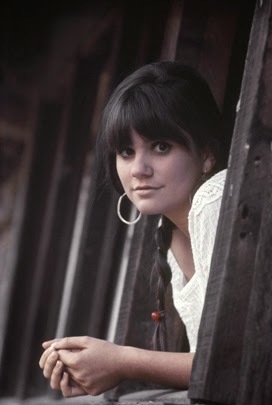 In the late 60s, an abandoned house in Topanga Canyon was used for the front cover of The Notorious Byrd Brothers (1968) and the back of Linda Ronstadt's Hand Sown Home Grown (1969). The Byrds were photographed by rock/celeb photographer Guy Webster at what he referred to as an old stable in Malibu Canyon, but the "house" has recently been spotted and verified one canyon over in Topanga, not far from the Topanga Corral.
In the late 60s, an abandoned house in Topanga Canyon was used for the front cover of The Notorious Byrd Brothers (1968) and the back of Linda Ronstadt's Hand Sown Home Grown (1969). The Byrds were photographed by rock/celeb photographer Guy Webster at what he referred to as an old stable in Malibu Canyon, but the "house" has recently been spotted and verified one canyon over in Topanga, not far from the Topanga Corral.The Byrds as pictured are: (left to right) Chris Hillman, Roger McGuinn, and Michael Clarke. Although David Crosby appeared on several tracks on the album, he had unofficially been fired from the band. There is speculation that the inclusion of the horse (rather than Crosby) was an inside joke, but Guy Webster denies the accusation. Linda Rondstadt appears on the right as photographed by Eddie J. Caraeff.

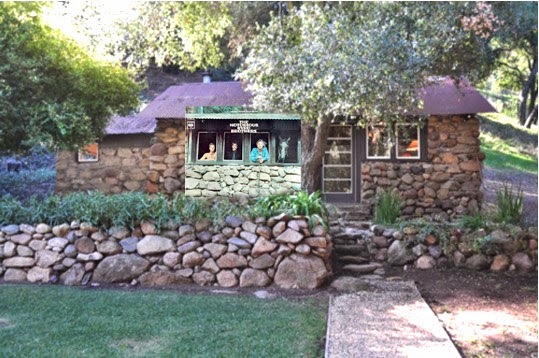 The album superimposed on the house as it appears today.
The album superimposed on the house as it appears today.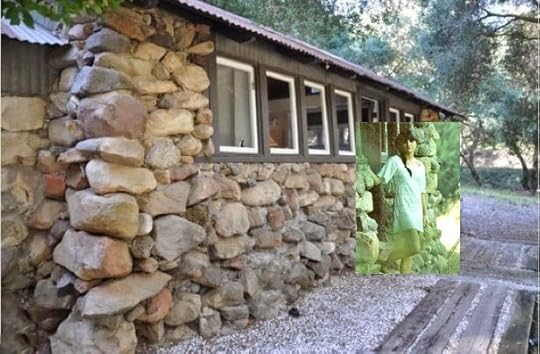 The house as it appears today with Linda Ronstadt from 1969
The house as it appears today with Linda Ronstadt from 1969
Published on May 17, 2020 05:31
May 16, 2020
Calif. - 50 Years Ago
While reading Calif., the reader is virtually transported to 1970. Through the setting and the visuals, the artists and the narration, we are whisked to a scene 50 years ago to the day. And so it is that on May 13, 1970, "in walked Neil Young." Miles has taken a job at a rock club up the coast – let’s listen in…
As I left the office, in walked Neil Young. He was somewhat imposing, kind of big, like a farmhand; like they grew them up big in Canada where there was lots of elbow room. He had a well-worn white shirt like you’d wear with a tuxedo, flared jeans and chukka boots. He sat on the couch and the fella with him plugged an acoustic guitar into an amplifier. He strummed it a couple times and handed it to Neil. Both of them said “Hey” to me, which was kind of nice.I found myself a table on the side and by showtime the place was packed. It was an intimate affair with Neil mostly at the piano. He did “Cinnamon Girl,” of course, and “Down by the River.” He sang “Tell Me Why” and a song called “Expecting to Fly,” and it was like we were all just hanging out. He did a new number that he said would be on the next album. It had some spacy, otherworldly lyrics interspersed with a romantic medieval vibe. It was called “After the Gold Rush.” He sang, “There was a band playing in my head, and I felt like getting high.” I looked at the girl across from me. She caught my eye and nodded as she bobbed her head to the beat, like everyone in the room was on the same wavelength. “Look at mother nature on the run in the nineteen-seventies,” he sang. You could have heard a pin drop.When the show was over, I found Mr. Chadwick. He asked how I liked it. I didn’t tell him that I could have cried, like it was the best homily I’d ever heard. As I said, you have to suck in the truth sometimes.I emptied ashtrays, filled the cigarette machine, washed glasses behind the bar, picked up empty beer bottles and put all the chairs upside down on the tables. There was lots of banter and Mr. Chadwick always had something sarcastic to say. He was pretty funny. Neil Young walked out the front door, and said “Later, kid,” as he passed. At the end of the night, it was about 2:30, Mr. Chadwick handed me a ten and a couple singles. It was a good day’s work. Dawned on me I’d never worked a day in my life.
Don't miss out on the magic. Calif. is available now on Amazon.
Published on May 16, 2020 05:36
May 15, 2020
The Moody Blues - Question - 50 Years Ago
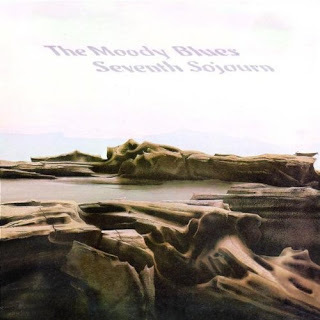 50 years ago a kid in Jr. High didn't know which way to turn. Atom Heart Mother was a bit over the top for me; I wouldn't discover Pink Floyd until Meddle, and that not when it was released. From Ten Years After to Derek and the Dominos, music pervaded my life. I'd heard Days of Future Passed because my brother had it, but "Question," released 50 years ago, was a single I discovered on my own.
50 years ago a kid in Jr. High didn't know which way to turn. Atom Heart Mother was a bit over the top for me; I wouldn't discover Pink Floyd until Meddle, and that not when it was released. From Ten Years After to Derek and the Dominos, music pervaded my life. I'd heard Days of Future Passed because my brother had it, but "Question," released 50 years ago, was a single I discovered on my own.You flip through the vinyl at your fave record shop and come across The Zombies. You know the songs, "Tell Her No," "She's Not There" and "Time of the Season," among the best singles the 60s had to offer, but you've never heard the misspelled LP called Oddessey and Oracle. Turns out to be one of the stellar albums of 1968, and you pick it up for a couple bucks because no one's ever heard of it. Like S.F. Sorrow, another dismissed tour de force, you figure it's a score and now you're privy to what others are not. Someday you'll happen upon Blue Cheer's Vincebus Eruptus or you'll find Badger's debut, a live LP, and buy it simply because of the incredible Roger Dean cover. So, it's dumb luck, but how can a band whose first seven LPs (discounting the fledgling debut), be so readily dismissed? Of course I'm referring to The Moody Blues. No doubt, die hard fans still flock to Red Rocks, but when we read of the greatest LPs of all time, the Moodys are mostly forgotten. Our little website can't fix that, but we can acknowledge a ten year stint that embraced pop and psychedelia like a boss. What follows may seem but a boring list. It's my justification for the elevation of The Moodys as one of the greatest bands in the rock canon, purveyors of the concept and the catalyst of art rock.
May 4, 1964: The Moody Blues, consisting of Denny Laine (lead vocals, guitar), who would go on to play guitar for Wings, Ray Thomas (vocals, tambourine, flute), Mike Pinder (vocals, mellotron, piano), Clint Warwick (vocals, bass guitar), and Graeme Edge (vocals, drums), form in Birmingham.
Spring, 1964: The single "Steal Your Heart Away/Lose Your Money(But Don't Lose Your Mind)" is released to commercial failure in the UK. The Moody Blues appeared on the UK TV series Ready, Steady, Go to promote the B side.
October, 1964: The Moody Blues record their debut The Magnificent Moodies at Decca Studios in West Hampstead, London.
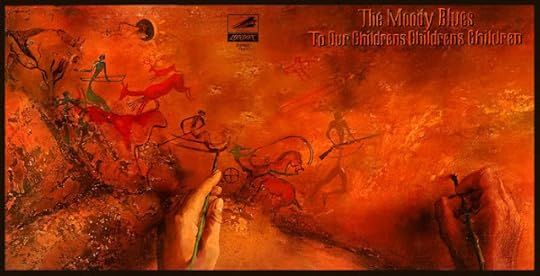
October 30, 1964: The Moody Blues perform at the Crawdaddy Club in London, England.
November, 1964: The single "Go Now," is released to critical and commercial success. The single peaked at No. 1 on the UK Singles Chart, and at No. 10 on the Billboard Hot 100 in the US.
July 22, 1965: The Magnificent Moodies, is released to regional, critical and commercial success. The album peaked at No. 5 in the UK, but failed to chart in the US.
October, 1966: Rod Clark departs from the Moody Blues. Denny Laine departs as well.
November, 1966: After a brief hiatus, The Moody Blues re-form, with John Lodge replacing Rod Clark on Bass Guitar and Justin Hayward replacing Denny Laine on lead vocals and guitar. Here then is where it gets good. For the next year, the Moodys face a lack of success that would have split the average band, but…October 8, 1967: The Moody Blues go into Decca Studios in West Hampstead, London, England, to record their second album, the concept album Days of Future Passed. Initially conceived as a merging of classical music and rock, the LP was meant as a stylized version of Antonín Dvořák's Symphony No. 9, also known as the New World Symphony. Of their own volition and despite Decca's new label, Deram, dismissing the idea,the concept LP was born (many will point to Pet Sounds and In the Wee Small Hours of the Morning, but that's splitting hairs) The concept of this album, a day in the life of everyman, features the London Festival Orchestra.
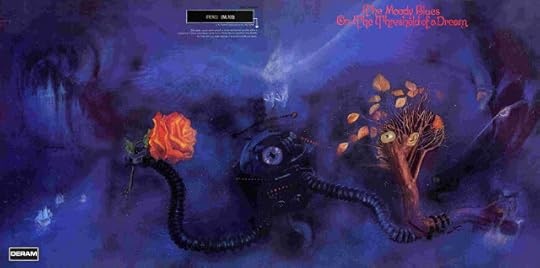
November 11, 1967: Days of Future Passed, featuring the songs "Tuesday Afternoon," and "Nights in White Satin," is released to critical and commercial success. The album peaked at No. 27 on the UK Albums Chart and No. 3 on the Billboard 200 in the US. "Tuesday Afternoon" peaked at No. 24 on the Billboard Hot 100, while failing to chart in the UK, and "Nights in White Satin" rose to No. 9 on the UK Singles Chart and No. 2 on the Billboard Hot 100 in the US, respectively.
January, 1968: The Moody Blues record In Search of the Lost Chord at Decca Studios in West Hampstead, London. The concepts of the LP are quest and discovery.
July 26, 1968: In Search of the Lost Chord, featuring the single "Ride My See-Saw," and cult fave "Legend of a Mind," is released to critical and commercial success.
November 8, 1968: The Moody Blues perform at the Electric Factory in Philadelphia, Pennsylvania.
November 24, 1968: The Moody Blues perform at the Fillmore West in San Francisco, California.

January 12, 1969: The band head back to Decca Studios to record their fourth album, the concept LP On the Threshold of a Dream. The concept, duh, is dreams.
April 25, 1969: On the Threshold of a Dream peaks at No. 5 on the UK Albums Chart and No. 23 on the Billboard 200 in the US.
May, 1969: Just three months later, The Moody Blues record their fifth album, yes, indeed, a concept LP, To Our Children's Children's Children.
October, 1969: The single "Watching and Waiting" is released to commercial failure, selling about ten copies (half of which were purchased by the Moody Blues themselves).
November 21, 1969: To Our Children’s Children’s Children is released to critical and commercial success. The album peaked at No. 2 on the UK Albums Chart and No. 14 in America.
January 17, 1970: The band record their sixth album, A Question of Balance.
April, 1970: The single "Question" is released to critical and commercial success. The single peaked at No. 2 in the UK and No. 21 on the Billboard Hot 100.
August 7, 1970: A Question of Balance is released to critical and commercial success. The album is their most successful, reaching No. 1 in the UK and No. 3 in the US.
November, 1970: The Moodys head to Wessex Studios in London to record their seventh album, Every Good Boy Deserves Favour.
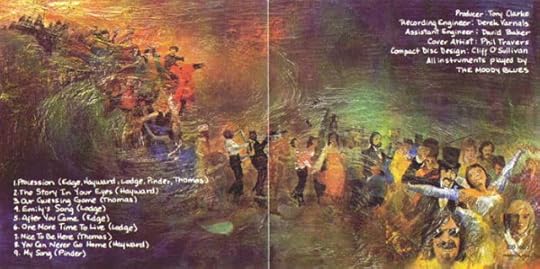
July 23, 1971: Every Good Boy Deserves Favour, featuring the songs "Procession" and "The Story in Your Eyes,"is released to critical and commercial success. The album rose to No. 1 on the UK Albums Chart and No. 2 on the Billboard 200 in the US. "The Story in Your Eyes" reached No. 23 on the Billboard Hot 100.
January, 1972: The Moody Blues go into Decca, Tollington Park Studios, London to record their eighth album, Seventh Sojurn.
April, 1972: The single "Isn’t Life Strange" is released to critical and commercial success.
November 17, 1972: Seventh Sojurn is released to critical and commercial success. The album makes No. 5 on the UK Albums Chart and No. 1 on the Billboard charts.
Published on May 15, 2020 07:27
May 14, 2020
Atom Heart Mother
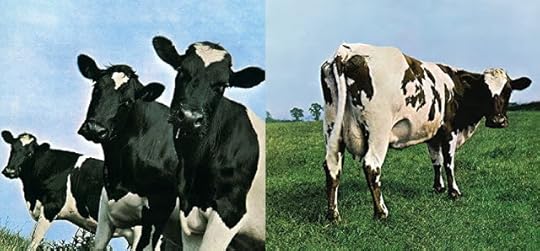 The cows on the cover of Pink Floyd's Atom Heart Motherare far more famous than the music within. Pink Floyd was a band of stages. The Syd years (Piper at the Gates of Dawn and Saucerful of Secrets), the impossible years (how could one band create four such monumental LPs?), the Roger Waters "solo" LPs (The Wall and The Final Cut), and the non-Roger Years.
The cows on the cover of Pink Floyd's Atom Heart Motherare far more famous than the music within. Pink Floyd was a band of stages. The Syd years (Piper at the Gates of Dawn and Saucerful of Secrets), the impossible years (how could one band create four such monumental LPs?), the Roger Waters "solo" LPs (The Wall and The Final Cut), and the non-Roger Years.There are those albums we skim over like the soundtracks for More and Obscured By Clouds, and then there's Atom Heart Mother. EMI records under L.G. Wood signed off on the LP which didn’t have the album's title or the name of the band, just pictures of cows, and still, the album made it to No, 1 on the British Charts.
Side One is the monumental title cut (23 minutes worth) which is unlike anything else Pink Floyd ever did, filled with orchestrations and experimentation; indeed it is the apogee of the experimental years. Pink Floyd by Atom had nixed the pop philosophy and until "Money" didn't release a single from 1978 to 1973.
Prior to Atom Heart Mother, the band had another soundtrack offering, Zabriskie Point, this time with odd bedfellows The Grateful Dead. Most of PF's material was cut from the soundtrack and that, mostly the creation of Gilmour, was the catalyst for the "Atom Heart Mother" suite.
Pink Floyd entered Abbey Road in early March to record on the studio’s newly installed state-of-the-art eight-track recorders. Waters and Mason recorded the backing track in one 23.44-minute take. "It demanded the full range of our limited musicianship," said Mason. "We added, subtracted and multiplied the elements, but it still seemed to lack an essential something." That “something” was the orchestration and choir, the work of Mason friend, Ron Geesin.
Waters' called the opening movement "plodding," but three minutes in, Gilmour's slide takes over, underpinning a mournful cello. Here one gets a taste of what Pink Floyd would soon achieve on Meddle and Dark Side. On the fourth movement, "Funky Dung," the guitar and Hammond organ play tag on what sounds a bit like "Any Colour You Like," while the choir's gospel-like vocals evoke those heard on "Eclipse." The suite’s fifth section, "Mind Your Throats Please," combines Nick Mason’s gruff "Silence in the studio!" warning with Rick Wright's piano as played through a Leslie speaker, a trick later used on "Echoes."
Side two is Pink Floyd at their most merry and poppy, more so even than the hit days of "See Emily Play" and "Paint Box." Side two concludes with the odd "Alan's Psychedelic Breakfast," with its run-on groove of a dripping faucet.
Atom Heart Mother is one of those deep Pink Floyd listens, but everyone should hear it once to see the direction the band would take with Meddle, and then, of course, with Dark Side of the Moon. You may even find yourself gravitating back to it – it does have an odd musical spell.
Published on May 14, 2020 07:22
May 11, 2020
Ummagumma - A Lesson in Mid-Floyd
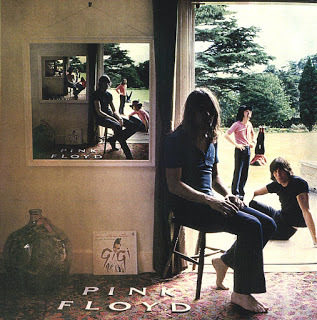 Ummagumma is that turning point between Syd's Pink Floyd (Piper and Saucerful) and Meddle. In a band like Yes, there is that iteration, from The Yes Album through Going For the One, that stands as the group's canon, with none of the rest of it really Yes. For Pink Floyd, though, there were two ensembles that co-exist: the Syd Barret years and beyond.Even with David Gilmour, the band that began as The Pink Floyd Sound had no real direction after Syd was whisked away to Wonderland. They'd made film scores for More and Zabriskie Point, which they shared equally with odd bedfellows The Grateful Dead, though unlike The Dead, the soundtracks showed Pink Floyd floundering. Nonetheless, the PF track “The Violent Sequence,” would later become “Us and Them” on Dark Side of the Moon.
Ummagumma is that turning point between Syd's Pink Floyd (Piper and Saucerful) and Meddle. In a band like Yes, there is that iteration, from The Yes Album through Going For the One, that stands as the group's canon, with none of the rest of it really Yes. For Pink Floyd, though, there were two ensembles that co-exist: the Syd Barret years and beyond.Even with David Gilmour, the band that began as The Pink Floyd Sound had no real direction after Syd was whisked away to Wonderland. They'd made film scores for More and Zabriskie Point, which they shared equally with odd bedfellows The Grateful Dead, though unlike The Dead, the soundtracks showed Pink Floyd floundering. Nonetheless, the PF track “The Violent Sequence,” would later become “Us and Them” on Dark Side of the Moon.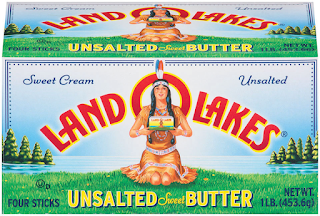 Ummagumma was released during that period as the first Harvest label LP. The album falls neatly into two parts: record one, a live recording (The Mother Club, Birmingham, 1969), and record two, a studio effort with half an album-side devoted to each of the four members. The live tracks are reworkings of the core material of the first two LPs in a bluesy style, interspersed with spaced-out movements that suggest what was coming next. "Set the Controls for the Heart of the Sun" and "A Saucerful of Secrets" are the definitive versions of these early year songs. And, of course, there's the haunting "Careful With That Axe, Eugene."
Ummagumma was released during that period as the first Harvest label LP. The album falls neatly into two parts: record one, a live recording (The Mother Club, Birmingham, 1969), and record two, a studio effort with half an album-side devoted to each of the four members. The live tracks are reworkings of the core material of the first two LPs in a bluesy style, interspersed with spaced-out movements that suggest what was coming next. "Set the Controls for the Heart of the Sun" and "A Saucerful of Secrets" are the definitive versions of these early year songs. And, of course, there's the haunting "Careful With That Axe, Eugene."The solo efforts are Richard Wright's "Sysyphus " (sic), a puzzling keyboard workout charting the Sisyphus myth replete with falling rock in an avant-garde tone poem.Roger Waters' "Several Species of Small Furry Animals Gathering Together and Grooving With a Pict" is an experimental spaced-out drug experience, I guess; at any rate, it's just what the title promises and my fave on the LP. "Grantchester Meadows" is little more than Waters sitting in a wheat field strumming an acoustic guitar, getting high. Fair enough.
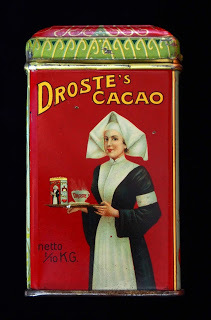 David Gilmour's "The Narrow Way" is the closest the studio disk comes to a standard bluesy Floyd song, and Nick Mason's "Grand Vizier" is a mixture of flutes and odd percussion that ends in a seven-minute drum solo. It is the lease inspired track on the LP. It's awful, actually.
David Gilmour's "The Narrow Way" is the closest the studio disk comes to a standard bluesy Floyd song, and Nick Mason's "Grand Vizier" is a mixture of flutes and odd percussion that ends in a seven-minute drum solo. It is the lease inspired track on the LP. It's awful, actually.The cover art by Hipgnosis is the last depiction of the band on an LP cover and is done utilizing the Droste Effect, kind of like when a mirror is reflected in a mirror, an illusion named for the Droste cocoa can. The other famous branding that utilizes the Droste Effect is Land O Lakes. What's different on Ummagumma is that the band members change positions with each iteration. The original cover is depicted below with the Broadway musical soundtrack, Gigi, leaning against the wall. This was airbrushed out for copyright infringement on later versions of the LP, only to return with the reissue.
Ummagumma is a lesson in Floyd, a survey of where they'd been and where they were going. Here's another lesson. It's Ummagumma, like the u in Gum, sometimes. Waters has said it both ways; Mason said it like the OO in zoom. So, IDK?
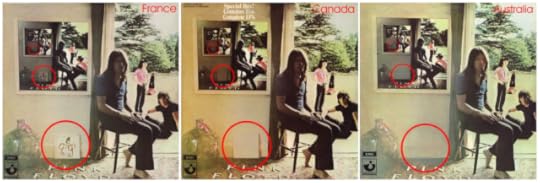
Published on May 11, 2020 14:04



